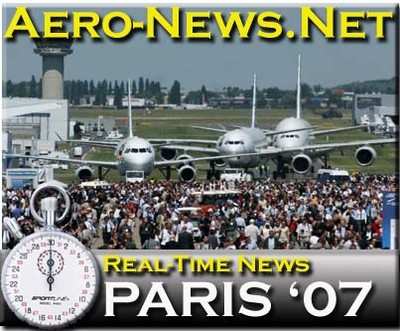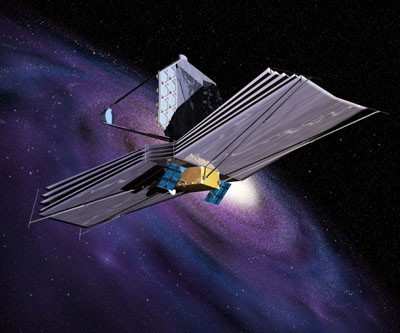Hubble Replacement Expected To "Revolutionize Our View Of The
Cosmos"
At a ceremony held Monday at the 2007 Paris Air Show at Le
Bourget, National Aeronautic Space Administration Administrator
Michael Griffin and European Space Agency Director General
Jean-Jacques Dordain signed two agreements defining the terms of
cooperation on the James Webb Space Telescope (JWST) and the Laser
Interferometer Space Antenna (LISA) Pathfinder mission.

The JWST is considered the successor to the Hubble Space
Telescope, although it will operate over a different range of
wavelengths. Its launch is targeted for 2013 and it will operate
for at least five years.
The telescope is a mission of international cooperation between
NASA, ESA and the Canadian Space Agency to investigate the origin
and evolution of galaxies, stars and planetary systems, according
to NASA.
 At the heart of the observatory is a
large telescope, which has a primary mirror measuring 21.3 feet in
diameter (compared to 7.9 feet for Hubble) that provides a
relatively large field of view.
At the heart of the observatory is a
large telescope, which has a primary mirror measuring 21.3 feet in
diameter (compared to 7.9 feet for Hubble) that provides a
relatively large field of view.
A set of four instruments, including a fine guidance sensor for
precision pointing, will combine imaging capability at visible and
infrared wavelengths with various spectroscopic modes to learn
about the chemistry and evolution of objects in our universe.
NASA says the telescope will operate well outside the Earth's
atmosphere at a spot in space called the second Lagrangian point or
"L2" located 1 million miles -- or four times farther than the
moon's orbit -- in the direction opposite the sun. From this
location, the observatory is expected to revolutionize our view of
the cosmos as Hubble has.
According to the agreement, NASA will be responsible for the
overall management and operation of the JWST mission and will build
the spacecraft, the telescope and the platform that will house the
instruments. ESA will provide an Ariane 5 ECA rocket for the
telescope's launch.
NASA also will provide a major instrument, the Near-Infrared
Camera, through the University of Arizona, Tucson. ESA will provide
the Near-Infrared Spectrograph operating over similar wavelengths.
NASA will also provide the instrument's detectors, which will
measure the wavelengths of light emanating from the stars being
observed.
NASA also will provide the microshutters, which are used to
select which star in the field of view will be observed by the
detectors.

The third instrument on board is the Mid-Infrared Instrument. It
is being built through a consortium of nationally funded European
institutions, which are responsible for the instrument's optical
assembly and NASA, with coordination through ESA.
Canada will provide the fourth instrument on board, the Fine
Guidance Sensor/Tuneable Filter Imager.
"The signing of this agreement on JWST, based on a long-standing
and consolidated cooperation between ESA and NASA, will make
history once more," said Dordain. "In particular, we are very proud
to use Ariane 5 to put this great observatory into space."
 "We're delighted to have ESA's
participation on the James Webb Space Telescope," said Griffin.
"The tremendous scientific success of the Hubble Space Telescope
can be attributed to the cooperative efforts between our two
agencies. We expect that, as Hubble's successor, the James Webb
Space Telescope also will make profound astronomical observations
and discoveries. When it does, we can be proud that it, too, is a
project of international cooperation."
"We're delighted to have ESA's
participation on the James Webb Space Telescope," said Griffin.
"The tremendous scientific success of the Hubble Space Telescope
can be attributed to the cooperative efforts between our two
agencies. We expect that, as Hubble's successor, the James Webb
Space Telescope also will make profound astronomical observations
and discoveries. When it does, we can be proud that it, too, is a
project of international cooperation."
At Tuesday's ceremony, the leaders of both agencies also signed
an official agreement on the ESA-initiated Laser Interferometer
Space Antenna (LISA) Pathfinder mission, currently targeted for
launch in early 2010. LISA Pathfinder is aimed at demonstrating the
technologies needed for a planned future joint ESA-NASA LISA
mission that will detect gravitational waves in space and test the
theory of general relativity.
Under this agreement, ESA will design, develop, launch and
operate the LISA Pathfinder spacecraft. A consortium of European
scientific institutes will provide the LISA Technology Package,
which features a sensor to detect non-gravitational forces on the
spacecraft.
NASA will provide the Disturbance Reduction System Package. That
package will work in tandem with the technology package and
consists of thrusters that produce a minute level of force,
combined with control systems and software.
 Airbus Racer Helicopter Demonstrator First Flight Part of Clean Sky 2 Initiative
Airbus Racer Helicopter Demonstrator First Flight Part of Clean Sky 2 Initiative Diamond's Electric DA40 Finds Fans at Dübendorf
Diamond's Electric DA40 Finds Fans at Dübendorf ANN's Daily Aero-Term (04.23.24): Line Up And Wait (LUAW)
ANN's Daily Aero-Term (04.23.24): Line Up And Wait (LUAW) NTSB Final Report: Extra Flugzeugbau GMBH EA300/L
NTSB Final Report: Extra Flugzeugbau GMBH EA300/L Classic Aero-TV: 'Never Give Up' - Advice From Two of FedEx's Female Captains
Classic Aero-TV: 'Never Give Up' - Advice From Two of FedEx's Female Captains






